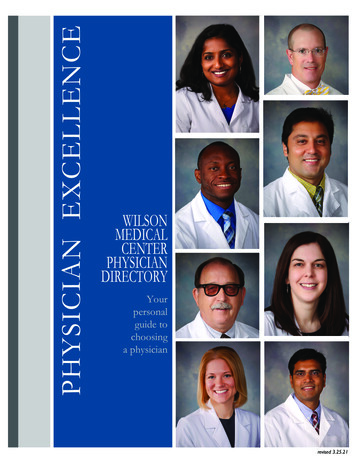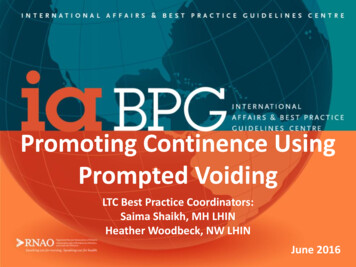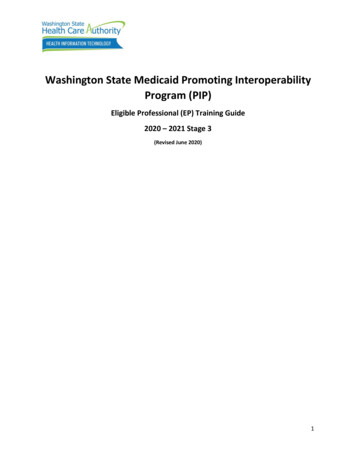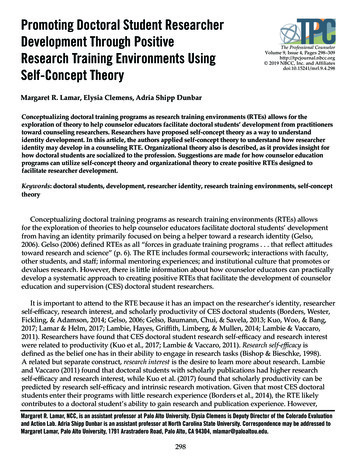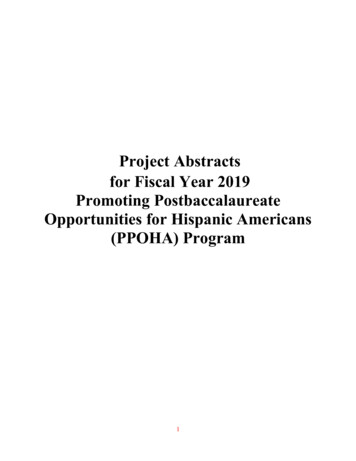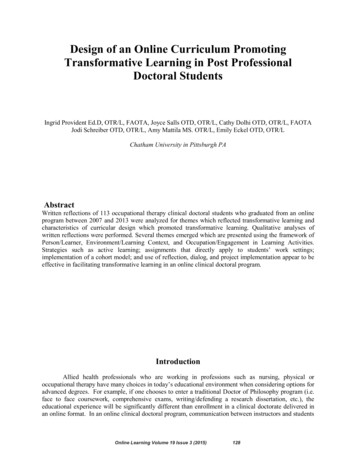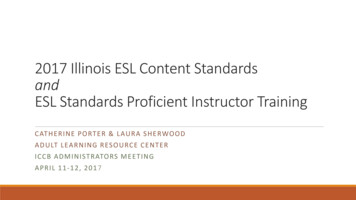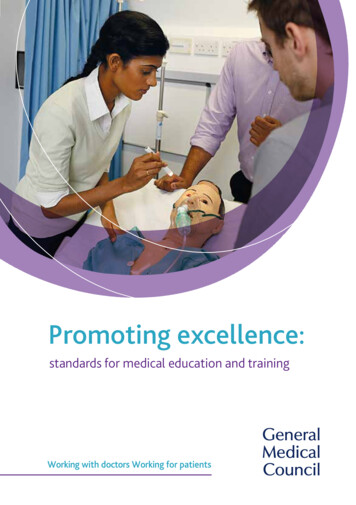
Transcription
Promoting excellence:standards for medical education and training
Promoting excellence: standards for medical education and trainingThe duties of a doctor registered withthe General Medical CouncilPatients must be able to trust doctors with their lives and health. To justify thattrust you must show respect for human life and make sure your practice meets thestandards expected of you in four domains.Knowledge, skills and performancen Make the care of your patient your first concern.n Provide a good standard of practice and care.l Keep your professional knowledge and skills up to date.l Recognise and work within the limits of your competence.Safety and qualityn Take prompt action if you think that patient safety, dignity or comfort is beingcompromised.n Protect and promote the health of patients and the public.Communication, partnership and teamworkn Treat patients as individuals and respect their dignity.l Treat patients politely and considerately.l Respect patients’ right to confidentiality.n Work in partnership with patients.l Listen to, and respond to, their concerns and preferences.l Give patients the information they want or need in a way they can understand.l Respect patients’ right to reach decisions with you about their treatmentand care.l Support patients in caring for themselves to improve and maintain their health.n Work with colleagues in the ways that best serve patients’ interests.Maintaining trustn Be honest and open and act with integrity.n Never discriminate unfairly against patients or colleagues.n Never abuse your patients’ trust in you or the public’s trust in the profession.You are personally accountable for your professional practice and must always beprepared to justify your decisions and actions.
Promoting excellence: standards formedical education and trainingPublished 15 July 2015.Comes into effect 1 January 2016.You can find the latest version of this guidance on our website atwww.gmc-uk.org/education/standards.asp.General Medical Council 01
Promoting excellence: standards for medical education and training02 General Medical Council
Promoting excellence: standards for medical education and trainingContentsPageAbout these standards04Patient safety is the first priority05The ten standards06Theme 1: Learning environment and culture08Theme 2: Educational governance and leadership16Theme 3: Supporting learners23Theme 4: Supporting educators28Theme 5: Developing and implementing curricula31and assessmentsReferences 38Glossary 40General Medical Council 03
Promoting excellence: standards for medical education and trainingAbout these standardsThe General Medical Council (GMC) sets the standards and requirements forthe delivery of all stages of medical education and training.Promoting excellence: standards for medical education and training sets outten standards that we expect organisations responsible for educating andtraining medical students and doctors in the UK to meet.The standards and requirements are organised around five themes. Somerequirements – what an organisation must do to show us they are meetingthe standards – may apply to a specific stage of education and training.Promoting excellence: standards for medical education and training replacesthe ‘standards for delivery of teaching, learning and assessment forundergraduate medical education’ in Tomorrow’s Doctors (2009), and the‘standards for postgraduate training’ in The Trainee Doctor (2011).04 General Medical Council
Promoting excellence: standards for medical education and trainingPatient safety is the first priorityPatient safety is at the core of these standards. Just as good medicalstudents and doctors make the care of their patients their first concern, somust the organisations that educate and train medical students and doctors.In non-clinical learning environments, there should also be a culture ofpromoting patient safety.We set out the professional values, knowledge, skills and behaviours requiredof all doctors working in the UK in Good medical practice.1 We also expectmedical students to meet these standards when they have contact withpatients. The learner’s* ability to develop the appropriate professional values,knowledge, skills and behaviours is influenced by the learning environmentand culture in which they are educated and trained.Patient safety runs through our standards and requirements. Patient safetyis inseparable from a good learning environment and culture that values andsupports learners and educators. Where our standards previously focusedon protecting patients from any risk posed by medical students and doctorsin training, we will now make sure that education and training takes placewhere patients are safe, the care and experience of patients is good, andeducation and training are valued.* Learners are medical students and doctors in training.General Medical Council 05
Promoting excellence: standards for medical education and trainingPromoting excellence: standards for medical education and trainingThe ten standardsTHEME 1Learning environment and cultureS1.1 The learning environment is safe for patients and supportive for learners andeducators. The culture is caring, compassionate and provides a good standardof care and experience for patients, carers and families.S5.1 Medical school curricula and assessmentsare developed and implemented so thatmedical students are able to achieve thelearning outcomes required for graduates.010205TIENSAFYETTHEME 5Developing andimplementing curriculaand assessmentsTHEME 2Educational governanceand leadershipPATS1.2 The learning environment and organisational culturevalue and support education and training so that learnersare able to demonstrate what is expected inGood medical practice and to achieve the learningoutcomes required by their curriculum.*S2.1 The educational governance system continuouslyimproves the quality and outcomes of education andtraining by measuring performance against the standards,demonstrating accountability, and responding whenstandards are not being met.S2.2 The educational and clinical governance systems areintegrated, allowing organisations to address concernsabout patient safety, the standard of care, and thestandard of education and training.S2.3 The educational governance system makes sure thateducation and training is fair and is based on principlesof equality and diversity.S5.2 Postgraduate curricula and assessments areimplemented so that doctors in training are ableto demonstrate what is expected in Good medicalpractice and to achieve the learning outcomesrequired by their curriculum.THEME 3Supporting learners03THEME 4Supporting educatorsS4.1 Educators are selected, inducted, trained,and appraised to reflect their educationand training responsibilities.S4.2 Educators receive the support, resourcesand time to meet their education andtraining responsibilities.06 General Medical CouncilS3.1 Learners receive educational andpastoral support to be able todemonstrate what is expected inGood medical practice and toachieve the learning outcomesrequired by their curriculum.04* For undergraduate education, the learning outcomes for graduates (Tomorrow’s Doctors)2 and forpostgraduate training, the curriculum approved by the General Medical Council.General Medical Council 07
Promoting excellence: standards for medical education and trainingTheme 1: Learning environment andculturePurposeThis theme is about making sure that the environment and culture foreducation and training meets learners’ and educators’ needs, is safe, open,and provides a good standard of care and experience for patients.Education and training should be a valued part of the organisational culture.Learners will have a good educational experience and educators will bevalued where there is an organisational commitment to, and support for,learning. High quality organisations will promote excellence in education.The clinical learning environment is multiprofessional, so an effectivelearning culture will value and support learners from all professional groups.ResponsibilityLocal education providers (LEPs) – specifically the leadership at board levelor equivalent – provide the learning environment and culture. They areaccountable for how they use the resources they receive to support medicaleducation and training. They are responsible for taking action when concernsare raised that impact on patient safety. They work with postgraduatedeaneries, local education and training boards (LETBs) and medical schoolsin recognising and rewarding trainers.308 General Medical Council
Promoting excellence: standards for medical education and trainingPostgraduate deaneries, LETBs and medical schools make sure that medicaleducation and training takes place in an environment and culture thatmeets these standards, within their own organisation and through effectivequality management of contracts, agreements and local quality controlmechanisms. They work together to respond when patient safety andtraining concerns are associated.StandardsS1.1 The learning environment is safe for patients and supportive forlearners and educators. The culture is caring, compassionate andprovides a good standard of care and experience for patients, carersand families.S1.2 The learning environment and organisational culture valueand support education and training so that learners are able todemonstrate what is expected in Good medical practice and toachieve the learning outcomes required by their curriculum.** For undergraduate education, the learning outcomes for graduates are set out in Tomorrow’s Doctors.2For postgraduate training, the curriculum is approved by the General Medical Council.General Medical Council 09
Promoting excellence: standards for medical education and trainingRequirementsR1.1 Organisations* must demonstrate a culture that allows learners andeducators to raise concerns about patient safety, and the standard ofcare or of education and training, openly and safely without fear ofadverse consequences.4R1.2 Organisations must investigate and take appropriate action locallyto make sure concerns are properly dealt with. Concerns affectingthe safety of patients or learners must be addressed immediately andeffectively.R1.3 Organisations must demonstrate a culture that investigates andlearns from mistakes and reflects on incidents and near misses.Learning will be facilitated through effective reporting mechanisms,feedback and local clinical governance activities.R1.4 Organisations must demonstrate a learning environment and culturethat supports learners to be open and honest with patients whenthings go wrong – known as their professional duty of candour – andhelp them to develop the skills to communicate with tact, sensitivityand empathy.R1.5 Organisations must demonstrate a culture that both seeks andresponds to feedback from learners and educators on compliance withstandards of patient safety and care, and on education and training.* Organisations that are responsible for the learning environment and culture.10 General Medical Council
Promoting excellence: standards for medical education and trainingR1.6 Organisations must make sure that learners know about the localprocesses for educational and clinical governance and local protocolsfor clinical activities. They must make sure learners know what todo if they have concerns about the quality of care, and they shouldencourage learners to engage with these processes.R1.7 Organisations must make sure there are enough staff memberswho are suitably qualified, so that learners have appropriate clinicalsupervision, working patterns and workload, for patients to receivecare that is safe and of a good standard, while creating the requiredlearning opportunities.R1.8 Organisations must make sure that learners have an appropriate levelof clinical supervision at all times by an experienced and competentsupervisor, who can advise or attend as needed. The level ofsupervision must fit the individual learner’s competence, confidenceand experience. The support and clinical supervision must be clearlyoutlined to the learner and the supervisor.Foundation doctors must at all times have on-site access to a seniorcolleague who is suitably qualified to deal with problems that mayarise during the session.* Medical students on placement must besupervised, with closer supervision when they are at lower levels ofcompetence.* This will normally be a doctor, but on some placements it may be appropriate for a senior healthcareprofessional to take on this role.General Medical Council 11
Promoting excellence: standards for medical education and trainingR1.9 Learners’ responsibilities for patient care must be appropriate fortheir stage of education and training. Supervisors must determine alearner’s level of competence, confidence and experience and providean appropriately graded level of clinical supervision.R1.10 Organisations must have a reliable way of identifying learners atdifferent stages of education and training, and make sure all staffmembers take account of this, so that learners are not expected towork beyond their competence.R1.11 Doctors in training must take consent only for procedures appropriatefor their level of competence. Learners must act in accordance withGeneral Medical Council (GMC) guidance on consent.5 Supervisorsmust assure themselves that a learner understands any proposedintervention for which they will take consent, its risks and alternativetreatment options.R1.12 Organisations must design rotas to:abcdemake sure doctors in training have appropriate clinical supervisionsupport doctors in training to develop the professional values,knowledge, skills and behaviours required of all doctors workingin the UKprovide learning opportunities that allow doctors in training tomeet the requirements of their curriculum and training programmegive doctors in training access to educational supervisorsminimise the adverse effec
15.07.2015 · the delivery of all stages of medical education and training. Promoting excellence: standards for medical education and training sets out ten standards that we expect organisations responsible for educating and training medical students and doctors in the UK to meet. The standards and requirements are organised around five themes. Some
